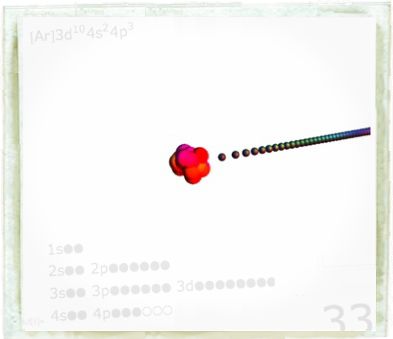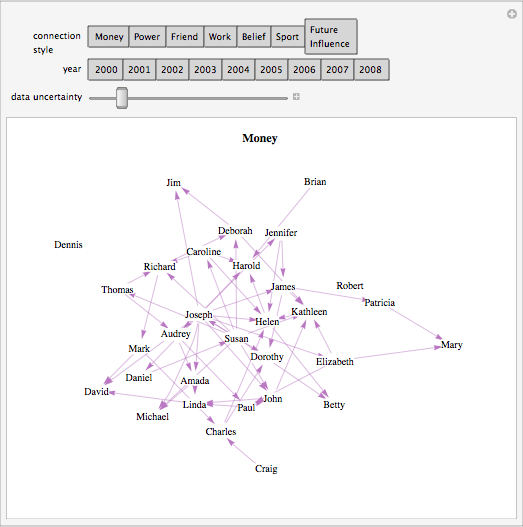



Non-Newtonian fluids
Beautiful Sunday morning on the empty campus. CHARLIE, LARRY,
AMITA, and ALAN huddle around a pool filled with milky water.
ALAN
Non-Newtonian Fluids?
CHARLIE
Non-Newtonian Fluids.
AMITA
(off Alan's look)
A fluid whose viscosity is variable
based on applied stress.
CHARLIE
You slap it, it acts like a solid --
Charlie slaps the top of the water -- it looks like he's
slapping at sand on the beach.
CHARLIE (cont'd)
You poke it, it's a liquid.
Charlie pokes his hand into the wet mass -- sloshing around,
proving it's liquid.
A non-Newtonian fluid is a fluid whose viscosity (i.e., resistance to flow or "stickiness") changes as a function of applied shear stress (i.e., the frictional force overcome as one "layer" of the fluid slides past another). Unlike most common fluids, non-Newtonian fluids lack well-defined values for their viscosities. Examples of fluids displaying non-Newtonian behavior include liquid polymers, corn starch in water, and even custard (though it takes a very high concentration of custard to see strong non-Newtonian behavior).
For some attractive images of non-Newtonian fluid effects, see the home page for Gareth McKinley's non-Newtonian fluid dynamics research group at MIT. The Brainiac program featured an enlightening and entertaining video of a man walking on custard. Note that in the latter, sudden application of stress (by walking briskly or trying to pull a leg out) makes the substance behave like a solid, whereas actions that produce less shear stress (such as standing still on the custard, running it through one's hands, etc.) make the custard behave like a fluid.
Riemann zeta function
ALAN
This is in your lesson plan why?
CHARLIE
It's an interesting study in
transitional system analysis --
ALAN
I thought you were teaching 'Advanced
Number Theory'?
CHARLIE
Well, the Riemann Zeta Function --
(busted)
...yeah.
AMITA
The students'll get a kick out of it.
ALAN
And by 'students,' you mean teachers.
There is essentially only a single Google hit for "transitional system analysis" as a quoted phrase, so we're not sure what Charlie is referring to here.
However, Charlie almost certainly would cover the Riemann zeta function in his advanced number theory class. The Riemann zeta function ζ(z) is an extremely important special function of mathematics and physics that arises in definite integration and is also intimately related with very deep results surrounding the prime number theorem. While many of the properties of this function have been investigated, there are important fundamental conjectures (most notably the Riemann hypothesis) that remain unproved to this day. The Riemann zeta function is defined over the complex plane for one complex variable (its real part, imaginary part, and absolute square are illustrated above both as three-dimensional plots and as contour plots), and was initiated by Georg Friedrich Bernhard Riemann in his classic 1859 paper. The Riemann zeta function is implemented in Mathematica as Zeta[s].
The Riemann hypothesis, first published in Riemann's groundbreaking 1859 paper and still open today, states that the nontrivial Riemann zeta function zeros (i.e., the values of s other than s = -2, -4, -6, ... such that ζ(s) = 0) all lie on the critical line σ = Re[s] = 1/2 (where Re[z] denotes the real part of z and the critical line can easily be discerned as the vertical line on the right side of the plot above). The position of the complex zeros can be seen by plotting the contours of zero real (red) and imaginary (blue) parts, as illustrated above. The zeros (indicated as black dots) occur where the curves intersect.
Note that we have previously met both the Riemann zeta function and the Riemann hypothesis in the Season 1 Episode 106 "Prime Suspect," in which Charlie realized that Ethan's daughter had been kidnapped because Ethan was close to solving the Riemann hypothesis (which allegedly would allow the perpetrators to break essentially all internet security).
Readers may also be interested to learn that in 2000, the Clay Mathematics Institute offered a $1 million prize for proof of the Riemann hypothesis. Interestingly, disproof of the Riemann hypothesis (e.g., by using a computer to actually find a zero off the critical line), does not earn the $1 million award.
Social and Bayesian network analysis
CHARLIE
I was about to tell Don that, unless
we have a thousand psychopaths, the
poisoner's motives and/or actions
should be detectable from the
'normal' social dynamics, whatever
those are.
FLASH CHARLIE VISION
of the CROSS SECTION of an apartment building... layers of
electrical and plumbing and cable TV line schematics laying
in...
BACK TO CHARLIE
CHARLIE (cont'd)
I could use Social and Bayesian
Network Analysis to uncover hidden
dynamics and covert architectures of
the cult.
LARRY
Nor would I so readily discount the
'thousand psychopaths' theory. What
kind of mindless cretins blind
themselves to the gifts of science?
DON
'Cretins?'
LARRY
(a little hot)
How else would a Creator speak to us?
Can they not imagine that denying
science is the same as defying God?

Network theory appeared previously in Episodes 216 ("Protest"; social network analysis), 310 ("Brutus"; networking theory), 316 ("Contenders"; social networks), 322 ("Under Pressure"; adaptive systems analysis), and 412 ("Power"; sexual networking models).
Beer and diapers
CHARLIE
Confidence is high it was not an
accident.
MEGAN
How does that change your Network
Analysis?
CHARLIE
Network Analysis was an analytic
sledgehammer. With the additional
murder, we were able to graduate to a
scalpel -- affinity analysis...
LARRY
... beer and diapers.
MEGAN
Okay -- I can't wait to hear this one --
LARRY
It's a classic -- and likely
apocryphal -- story --
ENTER AUDIENCE VISION --
Of a SUPERMARKET AISLE -- STACKS OF DIAPERS --
LARRY (cont'd)
-- about a supermarket that wanted to
know what product sold most often
with diapers...
-- then SIXPACKS OF BEER appear beside the diapers --
LARRY (cont'd)
... only to discover that the answer
was beer. They subsequently
discovered that the purchases were
most often made closer to the weekend
-- by men --
-- several 25-35 year old men appear in the aisle, filling
their carts --
LARRY (cont'd)
-- from which they inferred that
wives left the responsibility for
picking up diapers to their husbands,
who consolidated this duty into their
weekend beer run.
BACK TO SCENE --
LARRY (cont'd)
Using this information -- so the
story goes -- the store began placing
the diapers by the beer coolers,
which led to increased sales.
CHARLIE
Using affinity analysis and
association rule mining, we
determined it's highly probable that
the crimes were committed by a
partnership. So we reexamined the
relationships and behaviors of your
various suspects -- and kept coming
back to Audrey.
MEGAN
You think she's responsible for all
of this?
CHARLIE
More likely, someone's been sending
her out for the diapers.
Affinity analysis is a technique used in data analysis and data mining to identify correlations between actions and purchasing habits among individuals and groups. A common example of affinity analysis is the practice of shopping-cart and past purchase-history analysis used by many online businesses in order to make recommendations for other purchases or promotions. Such sophisticated mining techniques can also be superior to traditional approaches in retail knowledge discovery, such as frequent-buyer programs. In fact, affinity analysis can be used to enhance store arrangement, provide targeted coupons for competing products, and so on.
The prototypical (but possibly apocryphal) example of affinity analysis for product arrangement in a retail outlet is the observation that beer and diaper purchases tend to be correlated. While this is an initially surprising fact, it can be explained, as indicated by Charlie, by presuming that male shoppers asked to perform parental shopping duties frequently combine this chore with the purchase of mild intoxicants for use when done with child-duty.
T.J. Blischok considered another unexpected affinity in shopping patterns, namely an association between bottled juice and cold remedies. Another (but perhaps also apocryphal) example is tuna and toothpaste; as discussed by Noe Gutierrez, it seems that people who eat tuna are more prone to brush their teeth right after finishing their meal.
Affinity analysis also finds applications in other retail situations. A salient example is mentioned in a paper by H. L. Lee and S. Whang, who discuss Seven-Eleven of Japan's policy of adjusting its store layout and product placement multiple times every day in order to reflect the changing purchase patterns at different hours of the day. This in turn enables customers to easily find their favorite items. Furthermore, according to a research article by Yen-Liang Chen, Jen-Ming Chen, and Ching-Wen Tung, recent marketing research has suggested that in-store environmental stimuli (such as shelf-space allocation and product display) not only have significant influence on consumer buying behavior, but may in fact also induce additional demand.
K-optimal pattern discovery
Charlie and Larry work at the clear board.
CHARLIE
It's not working -- Craig/Audrey and
Craig/Susan have low support values,
and Craig alone has low predictive
value.
(beat)
Maybe we need to circle back around --
try K-optimal pattern discovery.
K-optimal pattern discovery is a data mining technique used to attempt to identify patterns that optimize a set of user-specified criteria.
References
Anonymous. "Data Mining Is More than Beer and Diapers." Chain Store Age 74, June 1998.
Blischok, T. J. "Every Transaction Tells a Story." Chain Store Age Executive with Shopping Center Age 71, 50-56, 1995.
Borin, N.; Farris, P. W.; and Freeland, J. R. "A Model for Determining Retail Product Category Assortment and Shelf Space Allocation." Decision Sciences 25, 359-384, 1994.
Brainiac. "John Tickle Walks on Custard."
Chen, Y.-L.; Chen, J.-M.; and Tung, C.-W. "A Data Mining Approach for Retail Knowledge Discovery with Consideration of the Effect of Shelf-Space Adjacency on Sales." Decision Support Systems 42, 1503-1520, 2006.
Clay Mathematics Institute. "Riemann Hypothesis." http://www.claymath.org/millennium/Riemann_Hypothesis/
Gutierrez, N. "Demystifying Market Basket Analysis." DMReview.com. October 2006. http://www.dmreview.com/specialreports/20061031/1067598-1.html
Han, J.; Wang, J.; Lu, Y.; and Tzvetkov, P. "Mining Top-K Frequent Closed Patterns without Minimum Support." In Proceedings of the International Conference on Data Mining, pp. 211-218, 2002.
Lee, H. L. and Whang, S. "Demand Chain Excellence." Supply Chain Management Review, 40-46, March/April 2001.
Liu, B.; Hsu, W.; and Ma, Y. M. "Integrating Classification and Association Rule Mining." KDD-98, pp. 80-86, 1998.
McKinley, G. "Gareth McKinley's Non-Newtonian Fluid Dynamics Research Group." http://web.mit.edu/nnf.
Riemann, G. F. B. "Über die Anzahl der Primzahlen unter einer gegebenen Grösse." Monatsber. Königl. Preuss. Akad. Wiss. Berlin, 671-680, Nov. 1859.
Webb, G. I. "OPUS: An Efficient Admissible Algorithm for Unordered Search." Journal of Artificial Intelligence Research 3, 431-465, 1995.
Webb, G. I. and Zhang, S. "K-Optimal Rule Discovery." Data Mining and Knowledge Discovery 10, 39-79, 2005.
Wikipedia. Affinity analysis, Non-Newtonian fluid.